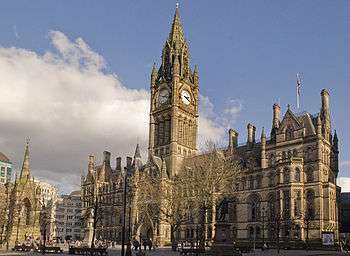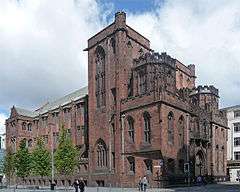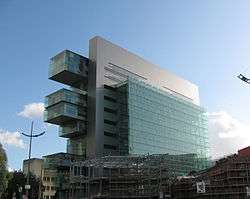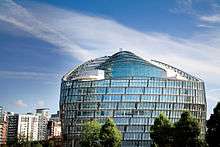Manchester Piccadilly station
| Manchester Piccadilly | |
|---|---|
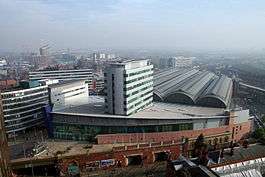 | |
| Location | |
| Place | Manchester city centre |
| Local authority | City of Manchester |
| Coordinates | 53°28′37″N 2°13′48″W / 53.477°N 2.230°WCoordinates: 53°28′37″N 2°13′48″W / 53.477°N 2.230°W |
| Grid reference | SJ847978 |
| Operations | |
| Station code | MAN |
| Managed by | Network Rail |
| Number of platforms |
14 (National Rail) 2 (Manchester Metrolink) |
| DfT category | A |
|
Live arrivals/departures, station information and onward connections from National Rail Enquiries | |
| Annual rail passenger usage* | |
| 2010/11 |
|
| 2011/12 |
|
| 2012/13 |
|
| 2013/14 |
|
| 2014/15 |
|
| Passenger Transport Executive | |
| PTE | Greater Manchester |
| Zone | City (D) |
| History | |
| 1842 | Opened as Store Street |
| 1847 | Renamed Manchester London Road |
| 1861 | Rebuilt |
| 1881 | Expanded |
| 1960 | Renovated and renamed Manchester Piccadilly |
| 2002 | Renovated |
| National Rail – UK railway stations | |
| * Annual estimated passenger usage based on sales of tickets in stated financial year(s) which end or originate at Manchester Piccadilly from Office of Rail and Road statistics. Methodology may vary year on year. | |
|
| |
Manchester Piccadilly is the principal railway station in Manchester, England. Opened as Store Street in 1842 and renamed Manchester London Road in 1847, it serves intercity destinations such as London (Euston), Birmingham, Bristol, Southampton, South Wales and Glasgow as well as other destinations throughout Northern England including Liverpool, Leeds, Sheffield, Newcastle and York. The station consists of 14 platforms; 12 of which are terminal platforms, the other two are through platforms situated to the south of the train shed.
Piccadilly is also a major interchange of the Metrolink light rail system, two platforms used by Metrolink trams are located in the station's undercroft, under the railway platforms.
Piccadilly is the busiest station in the Manchester station group ahead of Oxford Road, Victoria, Salford Central and Deansgate. With over 23 million passenger entries and exits between April 2012 and March 2013, it is the fourth busiest station in the United Kingdom outside London.[1] In total, six train operating companies operate services to and from Piccadilly. It is the second busiest interchange station outside London, with almost 3.8 million passengers changing trains at the station annually.[2]
The station received a five-year £100m refurbishment in 2002, which was the most expensive improvement on the UK rail network at the time.[3] According to an independent poll carried out in 2007, Manchester Piccadilly has the highest customer satisfaction level of any UK station, with 92% of passengers satisfied compared with the national average of 60%.[4] There are submitted plans to enlarge the station with two new through platforms as part of the Northern Hub with construction work expected to begin in 2016 and five new platforms as part of the High Speed 2 proposals.
History
A temporary terminus on Travis Street opened in June 1840 when the Manchester and Birmingham Railway (M&BR) opened its line to Stockport. In 1842 the company's Store Street station, consisting of two platforms and offices, adjacent to London Road, was completed and by then the line extended to Crewe. The Sheffield, Ashton-under-Lyne and Manchester Railway (SA&MR) shared the station from 1844 as the terminus of its line. The station name was changed to London Road in 1847 and it retained that name until 1960.[5]
Manchester London Road

The station was renamed London Road in 1847. In 1849, the Manchester, Sheffield and Lincolnshire Railway, which became the Great Central Railway, was formed.[5] The Manchester, South Junction and Altrincham Railway (MSJAR) opened its line from Manchester Oxford Road railway station to London Road on 1 August 1849 and built the MSJAR or South Junction platforms adjacent to the main part of the station.
London Road was overcrowded by the 1860s, and the relationship between the companies using it was poor. In 1862 the companies agreed to rebuild the station so it could be split in two. As traffic continued to increase the station was expanded and two spans added to the train shed in 1881.[5] The MSJAR platforms and the bridge over Fairfield Street were demolished and an island platform, on girder bridges, opened on 16 May 1882.
The adjacent Mayfield station opened in 1910 providing four platforms which alleviated overcrowding at Piccadilly. It closed to passengers in 1960 and closed permanently in 1986. The Mayfield station building still exists and can still be seen on approach to Piccadilly and from platforms 13 and 14.
During the first two decades of the 20th century, London Road station was served by the London and North Western Railway, the Great Central Railway and, by running powers, the North Staffordshire Railway. Following the 1923 railway grouping, the station was served by the London, Midland and Scottish Railway and the London and North Eastern Railway. After nationalisation in 1948, London Road station was operated as two independent stations, separated by iron railings on platform 5. On one side was the London Midland Region of British Railways; on the other was the Eastern Region.
Manchester Piccadilly
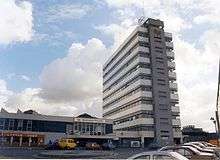
London Road station was renamed Manchester Piccadilly when it reopened after reconstruction on 12 September 1960 for London Midland Region electric train services to London. The MSJAR platforms and bridges over Fairfield Street were replaced. The island platforms (13 and 14) were located on a new pre-stressed concrete slab bridge with cantilevered sides for the tracks.
In the early 1970s, as part of the Picc-Vic tunnel project, there were proposals to build an underground station, Piccadilly Low Level.[6] The project was cancelled, and subsequent rail improvements concentrated on surface projects and the introduction of light rail. The station's undercroft, the two levels below the main rail platforms, was converted in the early 1990s to provide two platforms for the Manchester Metrolink tram system.
Piccadilly's island platforms were further rebuilt and lengthened in 1988 in connection with the opening of the Windsor Link. The glass roof over the terminal platforms was completely replaced in the late 1990s. The train shed is a Grade II listed building.[7]
In 2001–02, in preparation for the 2002 Commonwealth Games the remainder of the station was rebuilt to designs by BDP, increasing the size of the concourse and improving road access. Regular ticket checks are conducted by station staff between the concourse and train shed however Piccadilly was one of the largest stations in the United Kingdom not to have ticket barriers until they were installed to platforms 4-7 in mid-2016 by Virgin Trains.
Future

Various proposals have been put forward to alleviate capacity problems at Piccadilly Station. In 2009 the Greater Manchester Integrated Transport Authority advocated reopening the neighbouring derelict Mayfield Station; however this proposal has not been advanced, and development plans have focused instead on increasing track capacity on the cross-city route between Piccadilly and Oxford Road Stations.[8]
Northern Hub
Network Rail's 'Northern Hub' plans, costing over £560 million, aim to improve the heavily congested rail network on the approach into Manchester.[9] Two through platforms would be constructed at Piccadilly and the station linked to Manchester Victoria via the Ordsall Chord, cutting journey times on Trans-Pennine routes.[10][11] The Ordsall Chord will make it possible for trains from the airport to travel via Piccadilly's platforms 13 and 14 and Oxford Road to Manchester Victoria and Leeds and via the Calder Valley Line to Bradford Interchange. Construction started in 2015, with completion in time for the December 2016 timetable revision.
Phase 2 aims to alleviate congestion at platforms 13 and 14 by constructing a parallel elevated island platform (platforms 15 and 16) to end crowding and allow the minimum time between trains to be decreased from four to three minutes, improving reliability. It will allow four more trains an hour to be timetabled to Oxford Road, including a second freight to Trafford Park.[12][13] Approval for the platforms, at an estimated cost of £200 million, was announced in July 2012.[14] Construction, to be completed in time for the December 2018 timetable revision, should begin in 2016.
The proposals aim to simplify train operations at Manchester Piccadilly, creating close associations between pairs of lines leading out of the station and particular platforms, with few crossing moves. Through platforms 16 to 13 will be dedicated to services on the present 'slow' lines, to and from Manchester Airport and Hazel Grove; platforms 12 to 5 would be for services on the 'fast' lines, to and from Crewe and Stoke; and platforms 4 to 1 would be for services on the 'east' lines, to and from Marple, Glossop and Huddersfield.[15]
In July 2013 Network Rail opened consultation on three options for the additional platforms at Piccadily, all three of which would impact on local roads and the Grade II listed Star and Garter public house.[16]
High Speed 2
To accommodate High Speed 2 (HS2), an extension to Piccadilly would have four platforms and a 7.5 miles (12.1 km) tunnel would be built under south Manchester to join the West Coast Main Line at Ardwick. Journey times to Manchester Airport would be reduced to 9 minutes, Birmingham 41 minutes and London 68 minutes – from 18 minutes, 86 minutes and 128 minutes respectively. Station upgrades could include enhanced Metrolink services, improved road access and car parking. The line is planned to be completed by 2032.[17]
A major redevelopment of Piccadilly station and the surrounding area has been proposed to complement the HS2 plans; the project would involve the construction of a large new canopy over the HS2 platforms, the creation of a new entrance to the station, and new office, retail and residential buildings. Architectural designs indicate that the derelict Mayfield Station and the curved Gateway House office block will be demolished.[18][19] The plans were approved by the Government in November 2016.[20][21]
Northern Powerhouse Rail "High Speed 3"
As part of the HS3 plans there are plans to build new platforms under the current Piccadilly Startion and the proposed HS2 platforms (see above).
From the document released in March 2016. [22]
Addition of Northern Powerhouse Rail and Station to the Manchester Piccadilly system will be the last step of the process of transforming the station in to a transport super hub. The NPR station and its construction will need to be considered throughout the design and implementation of the other station improvements which form the station concept but which are delivered earlier. The NPR station is proposed to stay underground on its way east as it passes through Manchester city. This provides opportunities and o ers location and orientation alternatives. Staying under the existing Piccadilly station or positioning NPR under the HS2 station box will maximise interchange e ciencies and travel distances. The orientation will also dictate the number of vertical connection cores also referred to as “drums” and their locations. The drums will have the function to connect all levels of transport to one and other at critical junction points.
Architecture

The listed train shed roof which is 105 metres wide between platforms 1 and 12, has four spans, two spans 185 metres in length over the eastern part of the station date from the 1860s while the other two at the western side measuring 150 metres long were built in the early 1880s. The roof is supported by masonry walls with round-headed windows alongside platforms 1 and 12 and rows of cast iron columns. The roof spans have wrought iron trusses with cast iron struts on girders between the columns.[7] The original roof was covered with slates with some glazing. The slates were subsequently replaced with boarded felt. Between 1997 and 1999 the roof was refurbished and 10,000 panes of toughened glass 'float' above the wrought iron trusses.[23]
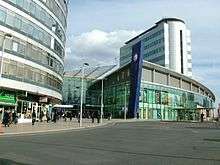
Below the train shed is an area once used as a goods station. Its cast iron columns and brick arches support the non-through platforms above. The area is now used by the Metrolink station, its tracks and sidings, as well as car parking. The columns were encased in concrete for protection against collision.
George W. Buck designed the original skew arch bridge over Fairfield Street with ten cast iron arch ribs as part of a long brick arch viaduct topped with open stonework parapets. The bridge was widened by adding wrought iron plate girders and transverse girders, supporting longitudinal joists with iron arch plates. As part of reconstruction in the 1960s the cast iron arches and spandrels were encased in concrete.[24] Platforms 13 and 14 are situated on the bridge.
The main entrance leads to a concourse with ground floor and mezzanine levels. The Fairfield Street entrance leads to the Metrolink station in the undercroft and is linked to the rail platforms by escalators. Redevelopment between 1997 and 2002 revised the station layout. A glass partition wall separates the concourse from the platforms.[25] The station's approach, constructed in 1969 along with the "wavy" fronted Gateway House by Richard Seifert, was modernised in 2003.[23]
Facilities


The Fairfield Street entrance, at basement level, serves the car park, the taxi rank, and the Metrolink station. Above it at track level is a concourse into which the main entrance feeds, housing ticket offices, information points, seating, timetables, toilets, shops, and food and drink outlets. Above the concourse is a second level of food outlets and bars, and the Virgin Trains First Class Lounge. On the main concourse, glass doors within a large glass partition lead to platforms 1 to 12. A travelator leads to the upper concourse linked by a footbridge, steps and lift to platforms 13 and 14. The island lounge contains retail outlets, toilets and a departure lounge. There are vending machines, waiting areas and snack bars on platforms 13 and 14.
Manchester Piccadilly is accessible for disabled people and has escalators and lifts to all levels, wide-access doors and gates, braille signs, hearing loops and disabled toilet facilities.
Cycle racks are available on Fairfield Street and the long-stay car park and next to the tower block at the station front. In March 2010, Manchester City Council and Network Rail unveiled plans for a 'Cycle Centre' to provide secure facilities, with maintenance and hire services.
The station has a taxi rank, drop-off/pick-up point, and short- and long-stay car parks[26] accessible from Fairfield Street.[26] The long-stay multi-storey car park is at the rear of the station.
Ticket barriers were installed in Autumn 2016 between platforms 3 and 7, following an application by Virgin Trains.[27]
National rail services
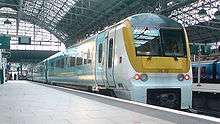

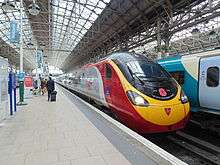

The station has 12 terminus platforms for services terminating from locations to the south of Manchester, and two through platforms, 13 and 14. The platforms are split into A and B sections to allow more than one train to stand. The through platforms 13 and 14 are used by through services via Manchester Oxford Road to North Wales, Liverpool, North West England, Glasgow and Edinburgh, and through services from Manchester Airport.
Manchester Piccadilly is currently served by six train operating companies:
- Local train services to stations in the Manchester area, primarily to destinations south and east of the city in Cheshire or Derbyshire and beyond. These include Hadfield, Glossop, Marple, Rose Hill Marple, New Mills Central, Sheffield via New Mills Central, Hazel Grove, Buxton, Crewe via Stockport or Manchester Airport, Stoke-on-Trent via Macclesfield, and Chester via Altrincham and Northwich.
- Services operate to the north and west to Liverpool Lime Street via St Helens Junction, Preston via Bolton and Southport via Wigan. Since 1 April 2016, Northern also operate the hourly service between Manchester Airport and Blackpool North that was formerly run by TransPennine Express (along with a small number of through trains to Barrow-in-Furness and Windermere via Lancaster).
These are operated by a variety of trains of Class 142, Class 150 and Class 156 Sprinter DMUs or Class 323 electric units.
- Hourly services via Chester and the North Wales Coast Line to Llandudno, calling at Manchester Oxford Road, Newton-le-Willows, Earlestown, Warrington Bank Quay, Runcorn East, Frodsham, Helsby, Chester, Shotton, Flint, Prestatyn, Rhyl, Abergele & Pensarn, Colwyn Bay, Llandudno Junction and Deganwy. Two trains per day run to Holyhead on weekdays only and some evening terminate at Chester. Certain services to/from North Wales have been extended to Manchester Airport since the May 2016 timetable change.
- Hourly services operate via Crewe, Shrewsbury and the Welsh Marches Line to Cardiff Central, with services continuing to Carmarthen or Milford Haven. There are once daily services to Tenby & Pembroke Dock and to Fishguard Harbour.
All services (except for the 10:30 departure) are booked for a Class 175 Coradia unit. Class 158 Express Sprinter and occasionally Class 150 Sprinter units when 175s are not available. Two services are operated by Mark 3 carriages hauled by a Class 67.[28]
- Hourly services to Bournemouth call at Stockport, Macclesfield, Stoke-on-Trent, Stafford, Wolverhampton, Birmingham New Street, Birmingham International, Coventry, Leamington Spa, Banbury, Oxford, Reading, Basingstoke, Winchester, Southampton Airport Parkway, Southampton Central, and Brockenhurst.
- Hourly services to Bristol Temple Meads call at Stockport, Stoke-on-Trent, Wolverhampton, Birmingham New Street, Cheltenham Spa, and Bristol Parkway. Some services continue to Exeter St Davids, Plymouth or Paignton.
All CrossCountry services are operated by Class 220 Voyager and Class 221 Super Voyager units.
- Hourly service from Liverpool Lime Street via Piccadilly to Sheffield and Nottingham, with most trains continuing to Norwich. These services are operated by Class 158 Express Sprinter units.
TransPennine Express operate services on three routes.
- The North TransPennine route has quarter-hourly services to Leeds via Huddersfield, with one train per hour continuing to Newcastle Central, Hull, Middlesbrough or Scarborough. In the opposite direction, one train per hour continues to Liverpool Lime Street and two to Manchester Airport. A two-hourly service to Leeds and York operates after midnight, providing a 24-hour service.
- The South TransPennine route runs from Manchester Airport via Piccadilly to Sheffield and Cleethorpes, operating hourly.
- The TransPennine North West route has an hourly service to Edinburgh Waverley or Glasgow Central (alternating) via Wigan North Western. In the opposite direction, this continues to Manchester Airport. These services to/from Scotland now operate along the newly electrified route over Chat Moss & Wigan North Western, though at least some will revert to their former route via Bolton when that route is electrified in 2017/18.
Class 185 Desiro units operate most TransPennine Express services, with the exception of the Scottish services which are operated by Class 350 Desiro units. The Class 185s were supplemented on the Hull and Cleethorpes services by Class 170 Turbostar units until February 2016 (these have now been transferred to Chiltern Railways).[29] A number of services on these routes to/from Manchester Airport start or end here.
- Three trains per hour to London Euston, two via Stoke-on-Trent and one via Crewe as part of the West Coast franchise, operated with Class 390 Pendolino units.
| Preceding station | Following station | |||
|---|---|---|---|---|
| Arriva Trains Wales | Terminus | |||
| Arriva Trains Wales | ||||
| CrossCountry | Terminus | |||
| CrossCountry | Terminus | |||
| East Midlands Trains | ||||
| TransPennine Express North TransPennine | ||||
| TransPennine Express TransPennine North West | ||||
| TransPennine Express South TransPennine | ||||
| Northern Manchester - Barrow/Blackpool/Preston/Windermere | ||||
| Northern Buxton Line | Terminus | |||
| Northern Crewe-Manchester Line | ||||
| Terminus | ||||
| Northern Hope Valley Line | Terminus | |||
| Northern Manchester-Glossop Line | Terminus | |||
| Northern Hope Valley Line | Terminus | |||
| Northern Mid-Cheshire Line | Terminus | |||
| Northern Liverpool-Manchester Airport via Newton-le-Willows or Southport-Manchester Airport | ||||
| Terminus | Northern Liverpool-Manchester Piccadilly via Warrington Central or Southport-Manchester Piccadilly | |||
| Terminus | Northern Manchester-Preston Line | |||
| Northern Stafford-Manchester Line | ||||
| Terminus | ||||
| Terminus | Northern Styal Line | |||
| Virgin Trains | Terminus | |||
| Future services | ||||
| Terminus | TBA High Speed 2 |
Manchester Interchange | ||
Metrolink tram stop
| Metrolink | |||||||||||||||||||||||||||||||||||||||||||||||||||||||||||||||||||||||||||||||||||||||||||||||||||||||||||||||||||
|
Piccadilly Metrolink station | |||||||||||||||||||||||||||||||||||||||||||||||||||||||||||||||||||||||||||||||||||||||||||||||||||||||||||||||||||
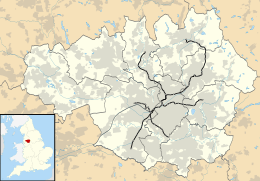 Piccadilly Location of Piccadilly in Greater Manchester | |||||||||||||||||||||||||||||||||||||||||||||||||||||||||||||||||||||||||||||||||||||||||||||||||||||||||||||||||||
| Location | |||||||||||||||||||||||||||||||||||||||||||||||||||||||||||||||||||||||||||||||||||||||||||||||||||||||||||||||||||
| Place | Manchester city centre | ||||||||||||||||||||||||||||||||||||||||||||||||||||||||||||||||||||||||||||||||||||||||||||||||||||||||||||||||||
| Local authority | City of Manchester | ||||||||||||||||||||||||||||||||||||||||||||||||||||||||||||||||||||||||||||||||||||||||||||||||||||||||||||||||||
| Coordinates | 53°28′37″N 2°13′48″W / 53.477°N 2.230°W | ||||||||||||||||||||||||||||||||||||||||||||||||||||||||||||||||||||||||||||||||||||||||||||||||||||||||||||||||||
| Grid reference | SJ848978 | ||||||||||||||||||||||||||||||||||||||||||||||||||||||||||||||||||||||||||||||||||||||||||||||||||||||||||||||||||
| Platforms | 2 | ||||||||||||||||||||||||||||||||||||||||||||||||||||||||||||||||||||||||||||||||||||||||||||||||||||||||||||||||||
| Fare zone information | |||||||||||||||||||||||||||||||||||||||||||||||||||||||||||||||||||||||||||||||||||||||||||||||||||||||||||||||||||
| Metrolink Zone | D (City) | ||||||||||||||||||||||||||||||||||||||||||||||||||||||||||||||||||||||||||||||||||||||||||||||||||||||||||||||||||
| Present status | In operation | ||||||||||||||||||||||||||||||||||||||||||||||||||||||||||||||||||||||||||||||||||||||||||||||||||||||||||||||||||
| Operations | |||||||||||||||||||||||||||||||||||||||||||||||||||||||||||||||||||||||||||||||||||||||||||||||||||||||||||||||||||
| Original operator | Manchester Metrolink | ||||||||||||||||||||||||||||||||||||||||||||||||||||||||||||||||||||||||||||||||||||||||||||||||||||||||||||||||||
| History | |||||||||||||||||||||||||||||||||||||||||||||||||||||||||||||||||||||||||||||||||||||||||||||||||||||||||||||||||||
| Opened | 4 June 1992 | ||||||||||||||||||||||||||||||||||||||||||||||||||||||||||||||||||||||||||||||||||||||||||||||||||||||||||||||||||
| |||||||||||||||||||||||||||||||||||||||||||||||||||||||||||||||||||||||||||||||||||||||||||||||||||||||||||||||||||
|
| |||||||||||||||||||||||||||||||||||||||||||||||||||||||||||||||||||||||||||||||||||||||||||||||||||||||||||||||||||

Manchester Piccadilly station is the terminus for Manchester Metrolink services to Bury and Eccles via MediaCityUK, and a major stop on the through service between Ashton-under-Lyne and Rochdale as well as the service between Etihad Campus and Altrincham. The Metrolink station, in a vaulted undercroft underneath the mainline station, is one of eight serving Manchester city centre, within the system's City Zone. Trams from Piccadilly Gardens run along Aytoun Street, on to London Road and along a short distance on segregated track, before crossing the road and entering the undercroft through a tunnel.
The station is the busiest on the Metrolink network. Originally one platform was used for arrivals from Altrincham/departures to Bury, and the other for arrivals from Bury/departures to Altrincham and all services to/from Eccles, with a crossover inside the station to allow access between platforms. The layout was altered to provide separate arrivals and departures platforms. Empty trams ran into a reversing siding in a tunnel to access the departure platform.[30] Since the opening of the first section of the extension towards Ashton in February 2013, the arrivals platform is used for departures towards Ashton as well as terminating trams from Piccadilly Gardens and beyond, while the departures platform handles arrivals from Ashton. Terminating trams use a reversing siding between the Ashton running lines between Piccadilly and the New Islington tram stop.
The tram station has been refurbished, and was the first to display the Metrolink corporate identity unveiled in 2008.[31] Station signage bears the yellow and silver livery as applied to the new generation of trams since 2009.[32]
Piccadilly was the eastern terminus of the Metrolink system, but was constructed to accommodate eastward extension. Proposals were approved for a 6 miles (9.7 km) extension to Ashton-under-Lyne.[33] The reversing sidings are part of this line, which exits the north side of the station towards Ancoats, Sportcity, Clayton Hall, and along Ashton New Road to Droylsden and Audenshaw.[34] Trams terminating at Piccadilly from the city centre use a new reversing siding to the east side of Sheffield Street. The East Manchester line was officially opened on 11 February 2013,[35][36] after a three-day free trial for local residents.[37]
In the early 1980s, proposals for a light rail system were based on converting existing railway lines to light rail operation (as with the Altrincham and Bury lines). Under these plans, eastward extensions from Piccadilly would have involved running Metrolink trams along the Glossop Line (to Hadfield and Glossop) and along part of the Hope Valley Line (to Marple and Rose Hill). These plans are no longer being pursued; however, the alignment this route would have used is still protected in 2010, with BRB Residual land disposals being altered by the ORR after a year-long consultation.
| Wikimedia Commons has media related to Piccadilly Metrolink station. |
| Preceding station | Following station | |||
|---|---|---|---|---|
towards Altrincham | Altrincham – Piccadilly Line | Terminus | ||
towards MediaCityUK | MediaCityUK – Piccadilly Line | Terminus | ||
towards Eccles | Eccles – Ashton-under-Lyne Line | towards Ashton-under-Lyne |
||
towards Bury | Bury – Etihad Campus Line | towards Etihad Campus |
References
- ↑ Steer Davies Gleave (May 2013). "Estimates of station usage 2011–12" (XLSX). Office of Rail Regulation. Retrieved 19 May 2013.
- ↑ "Estimates of Station Usage 2011/12" (PDF). Office of Rail Regulation. p. 19. Retrieved 19 May 2013.
- ↑ "£100m station revamp opens". BBC News. 9 December 2002. Retrieved 4 September 2011.
- ↑ "Revamped station tops train poll". BBC News. 2 August 2007. Retrieved 17 September 2008.
- 1 2 3 "Network Rail Archive – Manchester Piccadilly". Network Rail. Retrieved 3 November 2012.
- ↑ SELNEC Picc-Vic Line, SELNEC PTE, October 1971 publicity brochure
- 1 2 Historic England. "Train shed at Piccadilly Station (1283014)". National Heritage List for England. Retrieved 16 October 2012.
- ↑ "Forgotten station may return". Manchester Evening News. 24 March 2009. Archived from the original on 22 March 2015. Retrieved 22 March 2015.
- ↑ Manchester Hub Rail Study, Network Rail, February 2010.
- ↑ "£200 million boost for rail in Budget proposals". Railnews. Stevenage. 23 March 2011. Retrieved 24 November 2011.
- ↑ "The Missing Link: Rail line between Manchester Piccadilly and Victoria stations to boost jobs and business". Manchester Evening News. 5 April 2011. Retrieved 4 November 2011.
- ↑ Manchester Hub Rail Study, Network Rail, February 2010, page 49.
- ↑ Route Specifications 2011 – London North Western, Network Rail, 2011, page 35. See also pp. 25 to 30
- ↑ Investing in rail, investing in jobs and growth, Department for Transport, 16 July 2012
- ↑ Manchester Hub Rail Study, Network Rail, February 2010, page 57.
- ↑ "Our plans: Manchester Piccadilly". Network Rail. July 2013. Archived from the original on 18 July 2013. Retrieved 22 March 2015.
- ↑ "Phase Two Command Paper" (PDF). gov.uk. 28 January 2013. Retrieved 28 January 2013.
- ↑ "Mayfield SRF" (PDF). Bennetts Associates. 2014. Retrieved 21 March 2015.
- ↑ "Portfolio: HS2 Manchester Strategic Regeneration Framework". Bennetts Associates. Retrieved 22 March 2015.
- ↑
- ↑
- ↑ "Manchester Piccadilly Opitons Report" (PDF). 16 March 2016. Retrieved 13 October 2016.
- 1 2 Manchester Piccadilly Station, Engineering Timelines, retrieved 25 November 2011
- ↑ Fairfield Street Bridge, M&BR, Engineering Timelines, retrieved 25 November 2011
- ↑ Piccadilly Station, BDP, retrieved 3 March 2012
- 1 2 "Parking – Manchester Piccadilly". National Rail. Retrieved 2 March 2012.
- ↑ "Application for Ticket Gatelines – Manchester Piccadilly". Manchester City Council. Retrieved 8 November 2016.
- ↑ Notice Board North Wales Coast Railway 21 July 2014
- ↑ "FTPE to retain four Class 170s – but five will still go to Chiltern"Rail Technology Magazine 8 January 2015; Retrieved 16 August 2016
- ↑ "Metrolink Tram Stops: Piccadilly". TheTrams.co.uk. Retrieved 9 July 2009.
- ↑ "Work: a taster". Hemisphere Design and Marketing Consultants. 2008. Archived from the original on 14 March 2009. Retrieved 13 June 2009.
- ↑ "Tram design on the right track". Manchester Evening News. 4 October 2008. Retrieved 31 January 2009.
- ↑ "Metrolink Future Network" (PDF). GMPTE. 2006. Archived from the original (PDF) on 27 March 2009. Retrieved 28 December 2008. – map of the proposed network expansion
- ↑ "Manchester Metrolink Extension Project". Urban Transport Technology. Archived from the original on 11 June 2011. Retrieved 9 July 2009.
- ↑ Kirby, Dean (4 December 2012). "Opening of Metrolink tram service to Droylsden delayed until February 2013". Manchester Evening News. Retrieved 7 December 2012.
- ↑ "Droylsden's new Metrolink line to open in February" (Press release). Transport for Greater Manchester. 7 December 2012. Retrieved 7 December 2012.
- ↑ "It's the final countdown". Transport for Greater Manchester. 1 February 2013. Retrieved 7 February 2013.
Further reading
- Johnston, Howard (23 September – 6 October 1998). "Piccadilly: Regeneration is still not enough...". RAIL. No. 340. EMAP Apex Publications. pp. 42–44. ISSN 0953-4563. OCLC 49953699.
- "Manchester Piccadilly to close for major works". RAIL. No. 346. EMAP Apex Publications. 16–29 December 1998. p. 7. ISSN 0953-4563. OCLC 49953699.
External links
| Wikimedia Commons has media related to Manchester Piccadilly station. |
- Train times and station information for Manchester Piccadilly station from National Rail
- Station information on Manchester Piccadilly station from Network Rail
- More photos of the Metrolink station
| Manchester Lines | |||||||||||||||||||||||||||||||||||||||||||||||||||||||||||||||||||||||||||||||||||||||||||||||||||||||||||||||||||||||||||||||||||||||||||||||||||||||||||||||||||||||||||||||||||||||||||||||||||||||||||||||||||||||||||||||||||||||||||||||||||||||||||||||||||||||||||||||||||||||||||||||||||||||||||||||||||||||||||||||||||||||||||||||||||||||||||||||||||||||||||||||||||||||||||||||||||||||||||||||||||||||||||||
|---|---|---|---|---|---|---|---|---|---|---|---|---|---|---|---|---|---|---|---|---|---|---|---|---|---|---|---|---|---|---|---|---|---|---|---|---|---|---|---|---|---|---|---|---|---|---|---|---|---|---|---|---|---|---|---|---|---|---|---|---|---|---|---|---|---|---|---|---|---|---|---|---|---|---|---|---|---|---|---|---|---|---|---|---|---|---|---|---|---|---|---|---|---|---|---|---|---|---|---|---|---|---|---|---|---|---|---|---|---|---|---|---|---|---|---|---|---|---|---|---|---|---|---|---|---|---|---|---|---|---|---|---|---|---|---|---|---|---|---|---|---|---|---|---|---|---|---|---|---|---|---|---|---|---|---|---|---|---|---|---|---|---|---|---|---|---|---|---|---|---|---|---|---|---|---|---|---|---|---|---|---|---|---|---|---|---|---|---|---|---|---|---|---|---|---|---|---|---|---|---|---|---|---|---|---|---|---|---|---|---|---|---|---|---|---|---|---|---|---|---|---|---|---|---|---|---|---|---|---|---|---|---|---|---|---|---|---|---|---|---|---|---|---|---|---|---|---|---|---|---|---|---|---|---|---|---|---|---|---|---|---|---|---|---|---|---|---|---|---|---|---|---|---|---|---|---|---|---|---|---|---|---|---|---|---|---|---|---|---|---|---|---|---|---|---|---|---|---|---|---|---|---|---|---|---|---|---|---|---|---|---|---|---|---|---|---|---|---|---|---|---|---|---|---|---|---|---|---|---|---|---|---|---|---|---|---|---|---|---|---|---|---|---|---|---|---|---|---|---|---|---|---|---|---|---|---|---|---|---|---|---|---|---|---|---|---|---|---|---|---|---|---|---|---|---|---|---|---|---|---|---|---|---|---|---|---|---|---|---|---|---|---|---|---|---|---|---|---|---|---|---|---|---|---|---|---|---|---|---|---|---|---|---|
Legend | |||||||||||||||||||||||||||||||||||||||||||||||||||||||||||||||||||||||||||||||||||||||||||||||||||||||||||||||||||||||||||||||||||||||||||||||||||||||||||||||||||||||||||||||||||||||||||||||||||||||||||||||||||||||||||||||||||||||||||||||||||||||||||||||||||||||||||||||||||||||||||||||||||||||||||||||||||||||||||||||||||||||||||||||||||||||||||||||||||||||||||||||||||||||||||||||||||||||||||||||||||||||||||||
| |||||||||||||||||||||||||||||||||||||||||||||||||||||||||||||||||||||||||||||||||||||||||||||||||||||||||||||||||||||||||||||||||||||||||||||||||||||||||||||||||||||||||||||||||||||||||||||||||||||||||||||||||||||||||||||||||||||||||||||||||||||||||||||||||||||||||||||||||||||||||||||||||||||||||||||||||||||||||||||||||||||||||||||||||||||||||||||||||||||||||||||||||||||||||||||||||||||||||||||||||||||||||||||

